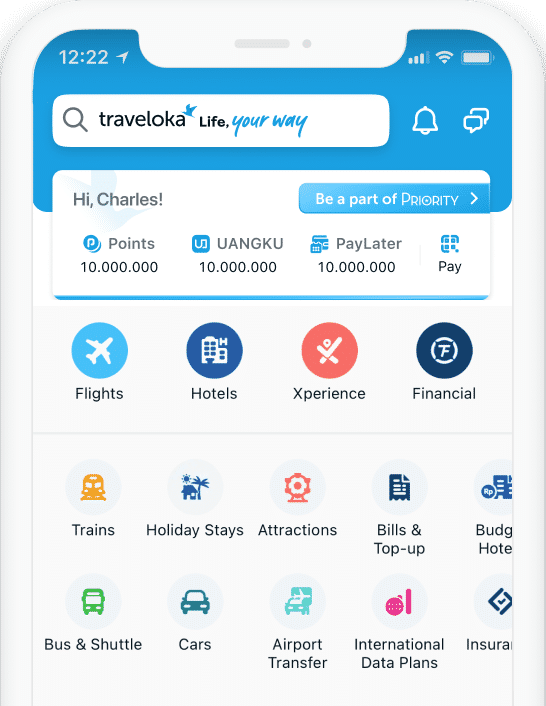
Hotels in Vietnam
Destinations to Discover




Popular Hotels in Vietnam
Discover what you like

About Vietnam
Vietnam occupies the eastern and southern part of the Indochinese peninsula in Southeast Asia, with the South China Sea along its entire coast. China is to the north and Laos, and Cambodia is to the west. Long and narrow on a north-south axis, Vietnam is about twice the size of Arizona. The Mekong River delta lies in the south.
About 2,000 years ago people in North Vietnam began growing rice in the Red River Valley. To irrigate their crops, they built dykes and dug canals. They were forced to work together, and so an organised kingdom emerged called Van Lang. However, in the 2nd century BC, the Chinese conquered the area. The Chinese ruled northern Vietnam for more than 1,000 years, and Chinese civilisation had a great impact on the Vietnamese.
However, in South Vietnam, there was an Indian influence. From the 1st century to the 6th century AD the southernmost part of Vietnam was part of a state called Funan. In the middle of Vietnam, an Indian influenced state called Champa arose in the 2nd century AD. In North Vietnam, the people resented Chinese rule, and in 40 AD the Trung sisters led a rebellion. They formed an independent state. However, in 43 AD, the Chinese crushed the rebellion, and the sisters killed themselves. The Chinese continued to rule North Vietnam until the 10th century. Finally, in 938, a leader named Ngo Quyen defeated the Chinese at the battle of Bach Dang River, and North Vietnam became an independent state. In the 13th century, the Mongols invaded Vietnam three times. In 1257 and 1284 they captured the capital, but each time they soon withdrew. Then in 1288 the Vietnamese leader Tran Hung Dao routed the Mongols at the Bach Dang River.
In the early 15th century China tried to regain control of North Vietnam. In 1407 they occupied the country, but their rule was resisted. In 1418 Le Loi began the Lam Son Uprising. By 1428 the Chinese were driven out, and Le Loi became the Emperor Le Thai To. Under his successors, the central Vietnamese state of Champa became a vassal state of North Vietnam. In the early 16th century, the power of the Le dynasty declined. During the 17th and 18th centuries, two rival families effectively held power, the Trinh in the north and the Nguyen in the south. The Nguyen family conquered the Mekong Delta from the Khmer Empire.
In the 1770s a rebellion began in the town of Tay Son. Three brothers called Nguyen led it. Gradually they took territory from the Nguyen lords in the south and the Trinh lords in the north. By 1786 they were in control of the whole of Vietnam and one brother, Nguyen Hue made himself Emperor Quang Trung. In 1788 the Chinese intervened in Vietnam, but the Vietnamese routed them at Dong Da. However, a Nguyen lord named Nguyen Anh escaped. He raised an army, and from 1789 he pushed back the rebels. Nguyen Anh took Hanoi in 1802 and made himself Emperor Gia Long. Under him, Vietnam became a strongly united kingdom.
Meanwhile, the Portuguese reached Vietnam by sea in 1516. In their wake came missionaries, first Dominicans then Jesuits and the Roman Catholic Church made some headway in Vietnam. In the late 19th century Vietnam became a French colony. However, the French took over Vietnam in stages. In 1859 they captured Saigon. Finally in 1883 North and Central Vietnam was forced to become a French protectorate. The French built infrastructure in Vietnam such as the Saigon to Hanoi railway. They also built roads and bridges. However, the building was funded by heavy taxation. Naturally, the Vietnamese wanted independence. The Communists spearheaded the struggle for independence. Ho Chi Minh founded the Revolutionary Youth League from the safety of China in 1925.
In 1930 it became the Vietnamese Communist party. In 1940 the Germans defeated France. Japan decided to take advantage of French weakness, and they forced the French government to allow Japanese troops to occupy French Indo-China, although they left the French administration in place. The Vietnamese Communists or Viet Minh fought the Japanese, and by 1945 they controlled parts of North Vietnam. Meanwhile, in March 1945, the Japanese took control of the administration of Vietnam, and when Japan surrendered on 15 August 1945, they left a power vacuum. Ho Chi Minh moved quickly to fill the vacuum. He called for an uprising called the August Revolution, and the Viet Minh took control of most of Vietnam.
On 2 September 1945 Ho Chi Minh declared Vietnam independent. However, the great powers ignored the Vietnamese demand for independence. Under the terms of the Potsdam Conference Japanese troops south of the 16th parallel surrendered to the British. Those to the north surrendered to the Nationalist Chinese. The French army soon arrived in the south to take control of the British. In the north Chinese troops moved in. However, Ho Chi Minh soon decided that the French were the lesser of two evils and he signed a treaty, which said that French troops should replace Chinese troops in North Vietnam for five years.
In return, the French promised to recognised Vietnam as a 'free state'. It soon became clear the French had no intention of giving up power in Vietnam and fighting broke out between them and the Viet Minh. For eight years the Viet Minh fought a guerrilla war against the French. Finally, in 1954, they surrounded a French army at Dien Bien Phu. After a siege lasting 57 days, the French were forced to surrender. By then it was clear that the French could not win the war and both sides met at the Geneva Conference to end the war. They agreed that Vietnam would be temporarily divided at the 17th parallel and elections would be held by 20 July 1956.
However, no elections were held, and the division of Vietnam became permanent. In the north, Ho Chi Minh introduced a Communist regime while in the south Ngo Dinh Diem became ruler. However, in the early 1960s, South Vietnam was rocked by demonstrations and in 1963 Diem was ousted in a coup. Meanwhile, in 1959, the North Vietnamese began a long guerrilla war to reunite Vietnam under Communist rule. The Northern Guerrillas were known as the Vietcong. Gradually the USA became involved in the Vietnam War. As early as 1950 the US sent military advisers to South Vietnam. Financially they supported the French and later the South Vietnamese government. Then in 1964 two US ships were supposedly subject to 'unprovoked' attacks by the North Vietnamese. First, the Maddox was attacked. Two days later the Maddox and a ship called the C Turner Joy claimed they were both attacked. (It is doubtful if this attack ever took place). The Americans then bombed the north, and Congress passed the Tonkin Gulf Resolution allowing the president to take 'all necessary measures' to prevent 'further aggression'.
As a result by December 1965 there were 183,000 US soldiers in Vietnam, and by the end of 1967, there were nearly half a million. However, the Vietcong continued their guerrilla war. In January 1968 the Vietcong launched the Tet offensive in towns and cities across South Vietnam. They suffered heavy losses, but afterwards, the Americans gradually withdrew from Vietnam. In January 1973 they signed a ceasefire, and the remaining American troops withdrew. The South Vietnamese continued to fight the Vietcong alone.
However, in the early months of 1975 South Vietnamese resistance collapsed and on 30 April 1975, the North Vietnamese captured Saigon. Vietnam was reunited under Communist rule. Then in the late 1970s, the Khmer Rouge made attacks on Vietnam. So in 1978, the Vietnamese occupied Cambodia. They stayed until 1989.
Meanwhile, in 1986, the Vietnamese government introduced market reforms. As a result, the Vietnamese economy began to grow rapidly. In 1994 the USA lifted an economic embargo on Vietnam and in 1995 diplomatic relations were restored. Today the Vietnamese economy is booming. Vietnam is becoming more and more prosperous. Tourism is an important industry in Vietnam. Furthermore, a stock exchange opened in Vietnam in 2000.
Today, the current population of Viet Nam is 96,885,456 as of Sunday, December 2, 2018, based on the latest United Nations estimates. Vietnam population is equivalent to 1.26% of the total world population. Vietnam ranks number 15 in the list of countries (and dependencies) by population. The population density in Viet Nam is 311 per Km2 (806 people per mi2). The total land area is 310,070 Km2 (119,719 sq. miles) where 35.2 % of the population is urban (33,991,799 people in 2018). The median age in Vietnam is around 31 years old. The current male population is now at 49.4% which consists of 48,006, 577 males whereas the current female population
is now at 50.6% with 49,078,951 females.
Vietnam`s climate can be divided a tropical and a temperate zone. It is characterised by strong monsoon influences, has a considerable amount of sun, a high rate of rainfall, and high humidity that makes it sometimes feel quite uncomfortable. Regions located near the tropics and in the mountainous regions have a slightly cooler, more temperate climate.
The annual average temperature ranges from 22°C to 27°C year-round. There are almost no significant differences in temperature in the southern parts of Vietnam, while the northern regions can be quite cold in the winter. There are essentially four distinct seasons, which are most evident in the northern provinces.
There are two distinguishable seasons in the southern areas. The cold season occurs from November to April and the hot season from May to October. The northern parts of Vietnam have essentially four distinct seasons, it can be quite cool in the winter there but very warm in summer
Hence, visitors are advised to do detailed research on which part of Vietnam are they going.
How to Get There?
By Flight
The tourists who come from Singapore will have to travel there by plane. They can take a flight at the Changi Airport. The ticket price is around $102-$450, depending on which part of Vietnam they are heading. Peak seasons like a public holiday and school holiday season will surely hike the price. Once they have arrived, they can take a taxi and head straight to their hotel.
What to Do There?
Khai Dinh Tomb in Hue
Blending both Vietnamese and European design elements, the architecture of the Khai Dinh Tomb in Hue has been described as Buddhist as well as Roman Gothic. Constructed in the 1920s, the tomb was commissioned by the Emperor of Vietnam as his future tomb. The entrance of the complex leads to the Honour Courtyard, and then on to the main building called the Thien Dinh. Khai Dinh’s final resting spot is marked by a bronze statue surrounded by beautiful murals.
Marble Mountains
South of Da Nang, Vietnam is the Marble Mountains. These five peaks are named after the five elements of earth, water, wind, fire and wood. The mountains are picturesque on their own, but they are also home to countless caves, some of which house incredible Buddhist sanctuaries. Some caves contain Confucian or Buddhist shrines, and others were used as sanctuaries and hospitals during the Vietnam War.
Where to Stay?
Banyan Tree Lang Co
Escape to a sanctuary for the senses at the stunning, multi-award winning Banyan Tree Lăng Cô in central Vietnam, a private paradise of luxurious all-pool villas nestled between the azure waters of the East Vietnam Sea and the Truong Son mountain range at Laguna Lăng Cô. This is the perfect destination for travellers who seek a luxury hideaway or a base from which to explore this beautiful area, which includes three UNESCO-listed World Heritage Sites: Hoi An Ancient Town, The Imperial Citadel of Hue and My Son Sanctuary. Step into a world of ancient and modern history, of unspoilt natural beauty and unparalleled luxury at Banyan Tree Lăng Cô.
Four Season Resort the Nam Hai
With an idyllic location on Vietnam’s culturally rich central coast, The Nam Hai offers a portal to three extraordinary UNESCO World Heritage sites and a breezy respite on the country’s most celebrated beach. You’ll have a chance to reconnect with your loved ones – whether you take to the East Sea by kayak, explore the glory of imperial Hue or savour the quiet moments in your tranquil villa.
Facts about hotel in Vietnam
Total Accommodation | 19,665 Properties |
Popular Region | Da Nang, Hanoi |
Popular Hotel | Melia Ho Tram Beach Resort, The Imperial Vung Tau Hotel & Resort |
Frequently asked questions
Traveloka is currently hosting the Traveloka EPIC SALE from 25th July. During this period, you can enjoy discounts of up to 50% on flights, hotels, and attraction tickets. Make sure to use the extra discount coupon code TRAVELNEW, which is valid exclusively in the Traveloka App for new users.
Highlights of the EPIC Sale include the EPIC Brand Day from 25th to 29th July 2024, offering even greater savings. Additionally, take advantage of EPIC Hour every day, where extra discounts are available for a limited time. Download the Traveloka App now to access these incredible deals and more. Don't miss out on the latest promotions on Traveloka!

Guest reviews in hotel near Vietnam
We’ve got more than just hotels




































 Facebook
Facebook Instagram
Instagram TikTok
TikTok Youtube
Youtube Telegram
Telegram